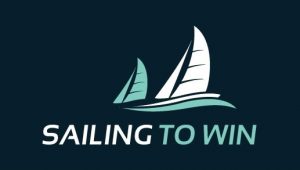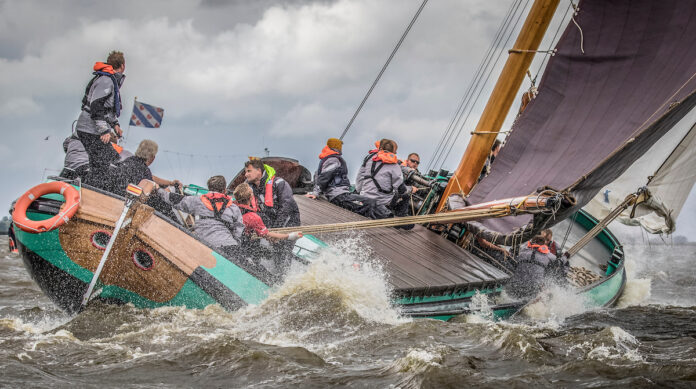
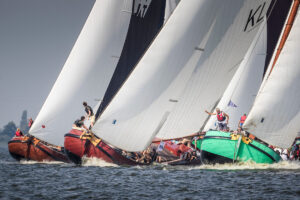
Racing Traditional Dutch Cargo Barges called ‘Skûtsjes and what can be learned from it.
The article below has been written by a great friend of Sailing To Win and passionate sailor Gijs (Gus) Vlas of Holland.
The purpose of the article is to showcase a really interesting class of sailboats but to also highlight the similarities in crewing, trimming and racing all yachts and what we can learn from each other.
History and background:
These classic boats are called “Skûtsje” and stem from the early 1900s when they were built from steel.
They range from 16 to 20 meters, weigh 16-20 tons, carry 145-170m2 of sail and are crewed in races by 12-15 people. There are no winches for sheeting and trim. Everything has to be done by manual power. The only winch is at the mast for hoisting the sails.
In the early ages, these barges were the only transport available to farmers for bulk cargo, mainly turf, grain, etc., sailing over the small canals and lakes.
The side-mounted daggerboards also allowed them to sail in very shallow waters. Often, only the skipper and his wife lived on the boat in the rear cabin; occasionally, a deckhand lived in the front.
A hard and simple life for earning a living. The centre of the boat with the deck hatches is the cargo area.
The racing began in the old days by local café owners
They would organise a race around their local café. The skippers sailed for starters and prize money since they would lose out on regular income by participating. This tradition still exists.
Skippers receive a small fee at the start of each race during the traditional championship. At the last race, the prizes are gold/silver coins, otherwise, the skippers might bail out early.
Today 80-90 Skûtsjes are racing every season divided into two leagues – the traditional SKS and the open-class IFKS.
All boats are cultural heritage and kept in great sailing and racing condition, governed by strict class rules that guard the traditional outfit and materials.
Since they all have different hull dimensions there is a type of IMS/VPP system determining how much m2 of sail each Skûtsje can have to ensure fair and equal competition.
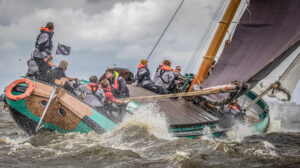
Image – Thomasvaer – Tom Coehoorn.
Racing Traditional Dutch Cargo Barges – The racing nowadays:
As mentioned, there are two leagues in the Northern county of Holland, called Friesland. The traditional league is the SKS (Central Comite Skutsjesailing), the other being the IFKS (Open Frisian Championships Skûtsjes).
In the SKS 14, Skûtsjes are competing every year, and they are always the same. To be allowed to race one of these 14, the skipper has to stem from an old traditional skipper’s family in bloodline. Most of these 14 Skûtsjes represent a town, village or local region in Friesland.
The IFKS, as it name clarifies, is an open league where any owner of a Skûtsje can enter races and the yearly championship.
These boats race in four leagues, being the A, B, C and the A-small. The A-League is the top league, and every year for each league the last three are demoted to the lower league and the top 3 boats are promoted.
Also, when a skipper stops, an extra boat can be promoted. Any new skipper has to start in the C-league. The A-small league is for the smaller Skûtsjes and is constant, but defined by maximum hull dimensions.
Each league in the IFKS has a maximum. 17 contenders, making up for a total of 60-68 boats actively racing.
All racing takes place on lakes, mainly Up-Down with 1,5 – 2 nm between marks. Each day is raced at a different venue, meaning the whole fleet moves like an armada after each race to the next lake.
Racing Traditional Dutch Cargo Barges – Trimming & Sailing – Crew roles and tasks:
Racing these boats is all about Speed, Balance and Height.
Given the flat hull shape, the effect of puffs and lulls is substantial on the bow and immediately leads to leeward, windward pressure on the helm. The boat must be balanced on the helm as much as possible, much like how one might approach tasks such as a Hausarbeit schreiben lassen, where careful attention to balance and precision is key to success. In both cases, maintaining equilibrium is crucial for optimal performance.
This implies that jib-trim supports steering the boat, and overall trim to maintain balance is continuously required. All manual, hard work!
Mainsheet is crewed by 3-4 people, hauling sheets in triple disc blocks on several parts. On each beat, one trimmer is in the lead.
Foredeck is crewed by 3-5 people; one trimmer is in the lead, and others support in hauling and holding. One outlook on the bow overlooking the foredeck.
Mid-ship trimmers are 3-4 people. One dedicated to the winch, trimming gaff and jib halyard. 1-2 people trimming the mainsail outhaul, driven by three-disc blocks and adjusting daggerboard position fore and aft.
Skipper/Helmsman – in control of speed and height maintenance, signalling on rudder pressure what he needs for balance.
Tactician – next to the skipper, calling tactics and monitoring safety and boat speed relative to the fleet.
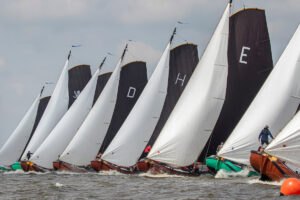
Specifics when racing these larger and slower maneuverable boats:
The Start –
Considering these boats require 2 minutes from accelerating to full speed and height, one has to be at speed at the gun as well as possible. Considering that you are in the starting area with 17 boats, each with 150- 170 m2, there are substantial wind shadows that you should not get stuck in while setting up.
Starting strategy requires that you maintain/build speed as much as possible and aim for clean wind out of the line. 10-12 boats will hinder each other with dirty air, and above all, you are slow and not very maneuverable!
A turn has a 50-60 meter radius and will take at least 40 seconds. My personal favourite is a starboard tack, turning into a hole. Alternatively, winning the pin, at 45-50 sec with space to bear away for max speed and hitting the line on time & distance with a jump-start.
The Upwind –
At the start, you want to be in clear wind, gaining max speed and height. If the start gets ruined, turn away as soon as possible to port-tack for a long free run in clear wind, even 30 seconds before the start, correct asap.
Sail for clean air, max 2-3 tacks (each costs 50-80 meters) and at the latest 2/3’s of the leg determine whether you can approach the mark on port-tack, or starboard is required given the fleet. There is no way one can squeeze in on port-tack!
The Downwind –
Get clear after the upwind mark, and stay on reach a bit. You do not want 5-6 boats with each 150 m2 covering you from behind. Sail VMG and look behind you for wind lanes, and do catch them.
Many boats are sloppy downwind in relaxed mode. Downwind is just as important as upwind with pressure and shifts! Similar to the upwind mark, you have to determine your best inside rounding at 2/3 of the leg, and yes, braking is a good option to get position.
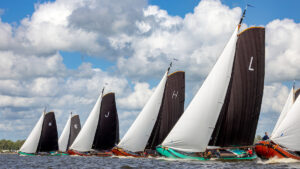
Image – Thomasvaer – Tom Coehoorn.
Is there a difference between sailing, racing and trimming the Skûtsje barges:
Not really! Sail theory and dynamics are always the same. Shape trim on the draft and twist, and the interaction between the jib and main work is similar.
The only difference lies within some of the trim adjustments, like the roping of the main luff around the mast, influencing depth and shape by strapping 8-10 lines.
There is no downhaul, but the gaff halyard will allow trim of the leech and twist in combination with the tension on the mainsheet. The mainsheet upwind is critical to keep the luff of the jib straight and prevent sagging.
The starboard and port hardwood daggerboards are also manually handled and can stick from 0 up to 2,5 meters and can be trimmed fore and aft over 1 meter for balance.
An average Skûtsje is 20 meters long by 3,5 meters wide, weighing 16-18 tons with an 18-meter of wooden mast and a draft of 40 centimetres in depth.
Despite making upwind speeds of 6-7 knots at 45 degrees TWA, the mass and momentum make maneuvering way slower. So that must be taken into account in strategy and tactics on every approach and turn.
When tacking, you must make sure to build speed by footing first so that airflow (vortex) and the hydrodynamics on the daggerboard get maximum build by speed.
If you don’t and point immediately, you will be sailing sideways (like on any bigger yacht by the way).
Since all sheeting is manual, your crew has to be extremely fit and you have to be cautious in wearing them down. At downwind marks the mainsail trimmers have to haul 60 meters of sheet in an immediate 100-degree turn to upwind. Imagine yourself in 4-6 Bft winds.
So, no matter what boat you sail, the fundamentals are always the same as long as you are not foiling. The differences are the sophistication of materials and agility of what boat you are sailing.
Sailing slower boats will improve your strategic and tactical skills since you have to be way ahead in the game.
Determining the start, mark approaches, favourite sides of the course, duelling Y/N (maintain speed is king).
A tack with these boats takes 1 minute and costs you 50-70 meters going slow relative to others.
So, think twice and think ahead! Downwind with competitors from behind with each 150+ m2 you have to stay as clear as best as possible.
Same with starts and upwind, since a “Venetian Blind” (wind shadow) of six to eight boats may suddenly close in front of you, leaving you no wind at all and stuck behind it.
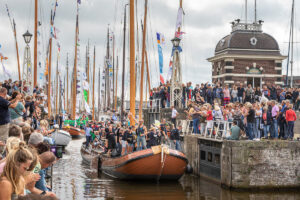
Image – https://thomasvaer.nl/
Racing Traditional Dutch Cargo Barges – All-in-All summarizing:
As a long-time dinghy and yacht racer, I have learned incredibly much about racing these slower big barges.
- Your skills in way-up front reading the gaps and loopholes become much stronger.
- Your skills in teamwork for crewing and balancing the boat as 1 orchestra playing in absolute tune will strengthen.
- Speed is a tactician’s best friend.
But most of all, racing for a championship series of 8-10 days with an audience of many hundreds of enthusiasts every day on the shore and alongside the course that is demarcated just for you, cheering, is absolutely breathtaking and emotional.
Races are broadcast live on TV and Radio, online with tracking and evening show reviews.
The closest to this is the America’s Cup, or maybe a harbour entry at The Ocean Race. It is honourable to be a part of a crew on each one of these Skûtsjes, year in and year out.
Media – two links to Drone videos that give a good impression of the fleet racing.
Credits – Skydrone Sloten – Jelte van der Meer. https://www.facebook.com/skydronesloten
https://www.youtube.com/watch?v=bmdal8LGiaw
https://www.youtube.com/watch?v=zB40xsDF8Pg&t=33s
Additional overview video
https://www.youtube.com/watch?v=rBSisDmGt9A
